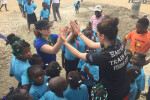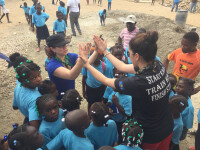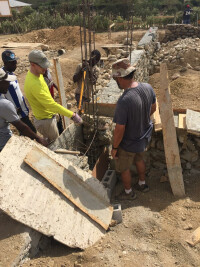Building a School and Relationships

In December of last year on the patio following a service, Fr. Mark invited me to join their group going to Haiti in February. In his joyful energetic way, he said, “Really! You should join us. You would be a great addition to our team!” I’m sure he says that to all the gals, but he had succeeded in planting a seed. After praying about it, confirming all the trip costs would fit into my budget and shifting around my schedule at work, I was ready to take my first plunge into hands-on outreach. Boy, am I glad I did!
After arriving in Port Au Prince and staying a night in the Hinche’ rectory, we made the ninety-minute drive on the off-road path they call a highway to Loranette, a village so small that Google maps doesn’t even find it unless you are actually there and drop a pin. We were greeted on the road about five minutes from the school by all the children and teachers. They lined the way enthusiastically singing, clapping and waving fresh leave-filled branches in welcome. Out of the trucks we hopped and then marched with the procession the last quarter mile to the school itself.
 I must admit that, in the past, I have been someone who sometimes hears about foreign aid and thinks, “Don’t we have enough poverty in the U.S.? Why are we helping those so far away?” Well, I was about to be introduced to whole new level of poverty which was hard to even comprehend.
I must admit that, in the past, I have been someone who sometimes hears about foreign aid and thinks, “Don’t we have enough poverty in the U.S.? Why are we helping those so far away?” Well, I was about to be introduced to whole new level of poverty which was hard to even comprehend.
The children range from preschool to elementary ages. They had on very well-worn, mismatched clothing. Some wore closed-toe shoes. The rest either had on old flip flops or no shoes at all. A few of them showed up in two or three different outfits as the week went on but most wore the same rundown clothes every day, but Sunday when they pulled out their best. By American standards, their best outfits, while clean, were still something you would see on very few of us at home.
The current “school” is a 20- by 25- foot framed structure that looks like a two-car carport with palm fronds and frayed tarps for walls. The 180 students were split into four classes by age, each with its own makeshift chalkboard comprised of a rough-edged piece of plywood and some chalkboard paint propped up on trimmed branches. Each of their “benches” was made of a long four-inch diameter log of wood wedged into two eight-inch-tall logs. Our group sat on them for a number of the worship services and, even though our American backsides have much more padding, the typical Episcopal pew aerobics were a welcome respite throughout the services.
 We were honored with a tour of the village and several homes. No buildings in the village have running water, electricity or even an indoor kitchen. They were built with tin roofs set upon walls made of woven sticks covered in mud and the floors were simply hard dirt. I can’t even imagine the muddiness that occurs during rainy season. There were no couches, chairs, televisions, video games, glass dishes or anything that we consider “normal” here in the United States. We saw the occasional small table or bed, all engineered from found scrap materials.
We were honored with a tour of the village and several homes. No buildings in the village have running water, electricity or even an indoor kitchen. They were built with tin roofs set upon walls made of woven sticks covered in mud and the floors were simply hard dirt. I can’t even imagine the muddiness that occurs during rainy season. There were no couches, chairs, televisions, video games, glass dishes or anything that we consider “normal” here in the United States. We saw the occasional small table or bed, all engineered from found scrap materials.
With all the poverty around them, one might think they would be a sad, woeful people. It was the exact opposite. They exhibited a zest for life and fellowship with others. After getting over a little shyness in the beginning, they had nothing but smiles for us and each other. They make due with so little in their community that I felt an overwhelming joy that St. Bartholomew was providing them with a way to work up out of that poverty. Empowering them with an education is a proven method of enabling them to grow and strengthen their abilities.
The building progress of the last few months is amazing. Construction started in November and the cinderblock school’s eight-room structure is already about two-thirds completed. It is wired for electricity that will be run by a generator and it has an indoor bathroom with a sink, toilet and shower. The “running water” is provided by a giant cistern on the roof that is literally filled one water jug at a time. They are brought in by donkey from the well about a half mile away and raised by a pulley system onto the roof. The cistern ran dry a few times during the week but they always refilled it. Their hospitality was humbling.
With only $17,000 left to complete the capital campaign, we are so close to completing the foundation of our ministry in Loranette: Epiphanie School. The original mission’s vision is coming to fruition very quickly, but our work cannot stop there.
Once the school is complete, St. Bart’s support can be used to build up the people of the village as well as the students in the school. Many creative ideas were generated during our trip - uniforms, school supplies, scholarships for those who cannot afford the 700 Haitian gourde (about $10 USD) annual tuition to attend the school, continuing education for the principal and the teachers so they can provide an even higher quality of instruction to the students.
If you have a chance to go on a future mission trip to Haiti, I recommend it with all my heart. It is a heart that God opened wide to be filled by the joy for life I saw in hundreds of faces every day that deserve to have the necessities I once took for granted - clean water, plentiful food, clothing not torn or frayed, education and too many others to list. The mission to build not only the school, but also the relationships, with a kind loving people who believe in the Lord with all they have is a huge blessing.
I don’t mean just for them. I mean for me.

Comments
Login/Register to leave a comment